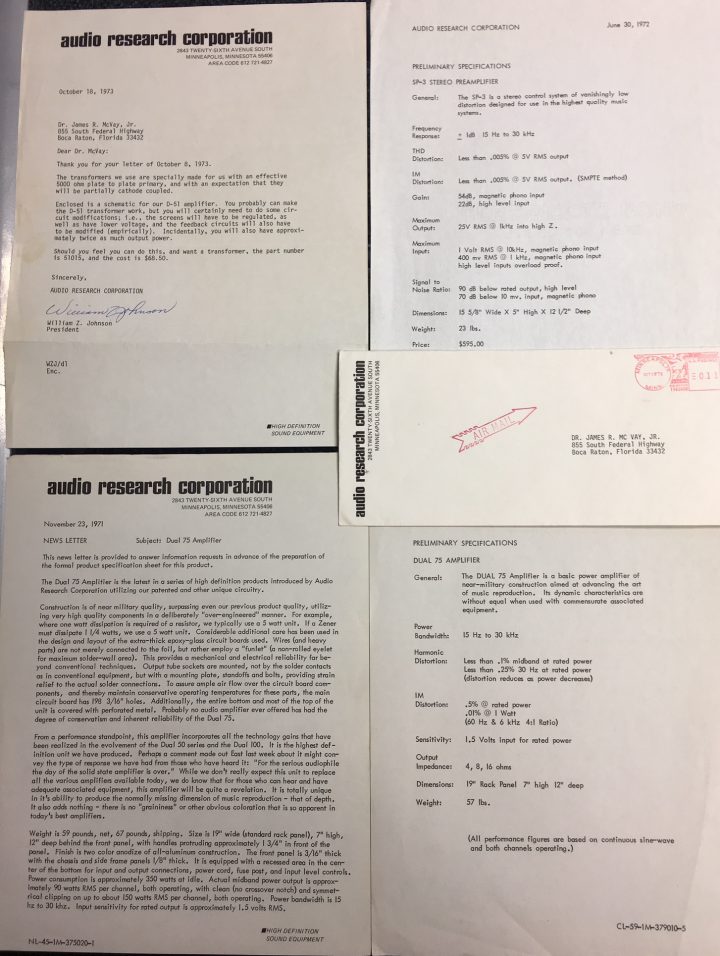I wrote about ephemera back in Copper #37. In that column I wrote (and I’m quoting myself because I don’t think I can say it any better now): “I also learned that there was a fancy name for the category of collectibles that included those [train] schedules, along with brochures, flyers, catalogs—all the stuff that was never expected to be saved. Because of the inherently ephemeral nature of such things—here today, gone tomorrow—that category is known as ephemera (ee-FEM-er-uh). A lovely name, no? Almost Biblical.”
Our itinerant recording engineer/DIY builder of things that don’t usually burst into flames, Duncan Taylor, plopped a black leatherette binder in front of me this morning. Having been bitten in the ass by all manner of legal documents in the past, I cautiously lifted the corner of the cover.
“This was my granddad’s stuff, ” Dunc said, as I leafed through a sheaf of receipts, warranty cards, manuals, booklets, and product literature. The stuff was all about audio gear—amps, tuners, speakers, cartridges, and turntables, from the ’50s to the ’70s.
“I guess the tube doesn’t fall far from the amplifier,” I said.
“Yeah, I got the bug from him,” Duncan said.
So what was in that binder?
My first impression was that I’d unearthed one of my Dad’s innumerable files. Dad also stashed receipts and warranty cards for things long-vanished from the face of the Earth. I’m not sure if pack-rattery was a trait of the Depression generation, or if it was just a coincidence. But there they were, dozens of palm-sized yellow and white paper receipts with the familiar bluish tracery of a multi-leaf pad, with the spidery handwriting and occasional misspellings characteristic of human effort. These days the anonymous machine-printed thermal paper receipts provide no evidence of human involvement, and that damned thermal crap will likely fade away in a decade. Someday, future generations will look at their forebear’s file folders, filled with slightly-sticky pieces of paper, all blank—and those future archaeologists will wonder, “what the hell—“.
Anyway. Not the case here. I recognized some of the companies listed on the receipts: David Beatty Stereo and Burstein-Applebee were still around in Kansas City back when I started in audio. House of Sound and Sight of West Palm Beach was still around in the ’70’s; that receipt in the center is for a P-E (Perpetuum-Ebner, a peculiar name, even more-peculiarly revived) turntable and a Bang & Olufsen SP-14 cartridge. The Allied receipts—a whole pile of them—all say “Allied Radio Shack”. I hadn’t realized that Allied was also a Tandy property in the chain’s declining years. Even more surprising was the discovery, courtesy of Wikipedia, that Allied is still around as a wholesale distributor.

Stuff. And lots of it.
Sorting the binder’s contents by category—once a student librarian, always a student librarian—I discovered a familiar batch of material from Audio Research Corporation, familiar because I’d received much of it from ARC myself. God bless those patient manufacturers who faithfully responded to the handwritten requests of 16-year-old me.
What I never had was a letter from company President, Bill Johnson, though I met him a number of times. Duncan’s grandfather, Dr. James McVay, may have been known to Johnson, judging by the friendly tone of the note. The rest of the batch was the familiar stuff: info on the then-new Dual 75 amp, news of the Magneplanar speakers then distributed by ARC, a schematic of the Dual 51, and the literature for the SP-3A-1 preamp. Not only had I had all the paper material, I’d had a tri-amped set of Maggie Tympanis with D-51s and D-75. The passive crossover is news to me (I’d had an electronic crossover, the EC-4), and it was good to see the familiar name of Wendell Diller—still around as Magneplanar’s sales manager.


 There were a few other pieces of literature and ephemera from the late ’60’s and ‘early ’70s: a JBL warranty card from the Arnold Wolf period (’69-’80) for the classic LE8T fullranger; a brochure for the AR-5, little brother to the AR-3a; an Empire full-range brochure, complete with cheesy sexist pics.
There were a few other pieces of literature and ephemera from the late ’60’s and ‘early ’70s: a JBL warranty card from the Arnold Wolf period (’69-’80) for the classic LE8T fullranger; a brochure for the AR-5, little brother to the AR-3a; an Empire full-range brochure, complete with cheesy sexist pics. 

But the mother lode was an assortment of material from the mid-to-late ’50s. Some of it was really eye-opening.
You guessed it: we’ll go into those goodies in the next issue of Copper.

0 comments